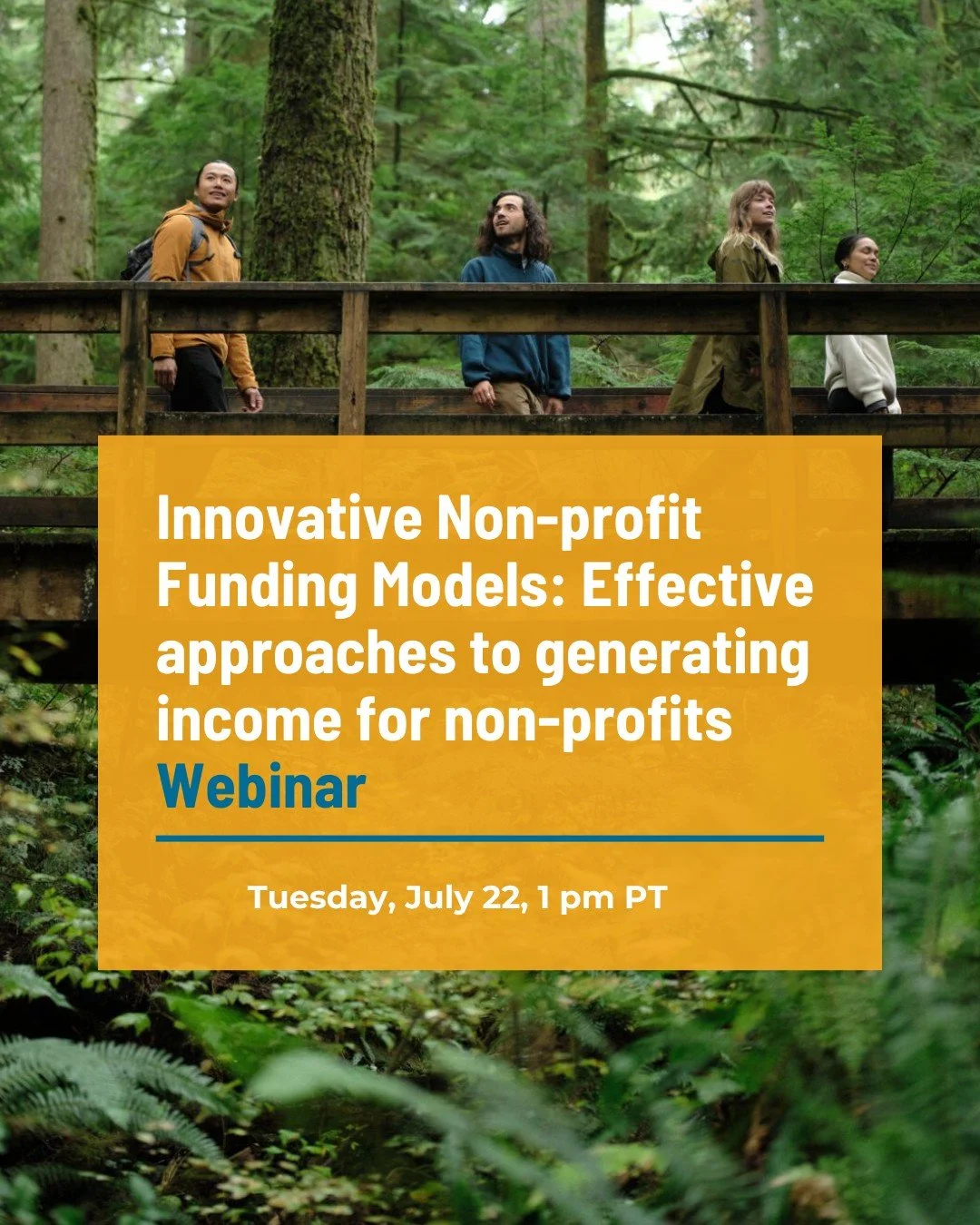Innovative non-profit funding models: Effective approaches to generating income for outdoor groups.
Webinar Summary
Are you searching for fresh ways to sustain your organization’s mission? While membership fees and grants are tried-and-true, there are lots of other ways of funding your operations. In the Outdoor Recreation Council of BC's July webinar, we investigated examples of non-traditional funding for investing in outdoor recreation from Cumberland, Tri-Cities and the Bulkley Nechako Regional District.
You’ll hear from three guests who shared their expertise:
Dougal Browne, Executive Director of United Riders of Cumberland, will share how he’s cultivated diverse funding streams to maintain over 200 km of mountain bike trails (dougal@unitedridersofcumberland.com)
Chris Cook, Tri-Cities Off Road Cycling Association, brings expertise in helping the club find creative ways to raise money for its projects and operations (chris@torca.ca)
Jason Llewellyn will introduce how local governments can play a role but highlighting the Recreation Contribution Grant Program developed by the Regional District of Bulkley Nechako (jason.llewellyn@rdbn.bc.ca)
Watch the webinar Recording
Download the presenters’ slides
Six Key Takeaways
Continue reading below for more details on each one.
Raise the stoke: By continually working to elevate the outdoor recreation experience, more funding opportunities will follow.
Many eggs, many baskets: Cultivate many different funding streams rather than relying on a small number of large ones.
Be creative: Look for creative opportunities in unusual places: donation opportunities at outdoor consignment stores, new membership structures, recruiting in-kind sponsors who may become financial supporters, and kids’ summer camps. Many small revenue sources can add up.
Use government contacts: Local and regional economic development agencies are great resources for funding ideas and grant writing support.
Be seen and heard: Invest in showing and telling supporters the impact of their contributions to build long lasting relationships.
Philanthropy’s promise: Family foundations and philanthropists represent a huge potential, and often untapped, funding source for outdoor recreation.
More takeaways from the webinar
Manages 200 km+ of self-propelled trails (primarily built for mountain biking) in the forest beside the town of Cumberland on Vancouver Island. 250,000 annual uses, $350,000 to $500,000 budget.
Dougal highlighted two strategies for ensuring consistent year-to-year funding:
Raise the Stoke: by improving the trails and trail network, UROC makes the mountain bike experience better, which makes it easier to encourage users to support the work by becoming paying members. More enthusiastic members and users makes it easier to win grants, sponsors, and other supporters, attract events, etc. This is a continuous effort that builds on membership and funding year over year. $24K in memberships in 2019 to $93K in 2024.
Many eggs, many baskets: rather than rely on a couple of funding main sources, UROC has cultivated many different funding streams. If one source is not available one year, they have many others to fall back on.
Examples of their many funding sources:
Membership
Sponsorship
Fundraising/donations
Grants - yearly funding with Village of Cumberland and Regional District
- other sources: Destination BC, local DMO, MBTA, Benevity Fund
Collaborations - w local businesses, like $1 from a dedicated beer from a local brewery; UROC labeled clothing made by other businesses
Events and races
3rd party events - races using the trail network pay a per racer fee to get a use permit UROC merchandise sales - their own product sales, like maps, trail name book, hats, etc.
Trail crew contracts - UROC trail crew contracts to maintain other jurisdictions trail networks out
Consignment - UROC set up an account at a local sporting good consignment store where people can donate their used equipment to benefit the club
RDBN Recreation Contribution Grant Program
In 2019, the Regional District of Bulkley Nechako (Smithers to Vanderhoof) conducted a parks and recreation needs study. The study is a recognition that “quality of life is more important than in the past,” Jason says. In northern B.C., “we’re not chasing industry anymore. Instead, regions are competing for residents.” The review made two recommendations:
1. The RD should get more involved in recreation.
2. Recreation societies need help with operational funding.
The result:
Four electoral areas within the RD opted in to a recreation grant program funded through a property tax of $1 to $1.50 per household.
Funds must be used for operational expenses like equipment, supplies and labour.
Created a pool of $225,000, plus an emergency fund for wildfire recovery, etc.
Fund provides up to $15,000 for three years to outdoor recreation focused non-profits.
Provided assistance with grant writing and application.
Grant distribution overseen by committee within each electoral area.
Funded 15 groups with an average of $12,500.
Variety of projects funded: new dock, trail improvements, grooming equipment
Allowed some flexibility for how funds were used.
Next intake planned for 2026 and may extend from 3 to 5 year funding term.
Advice for groups looking for funding:
Connect with local government - many have assistance programs to help identify potential grants and assist with grant writing.
Contact local Regional Manager in the Ministry of Jobs and Economic Growth. They are a great resource for local funding opportunities. Alex Denis, Regional Manager in the East Kootenays, issues an excellent quarterly newsletter with funding sources - email Alex (Alex.Denis@gov.bc.ca) to be added to the email list.
Tri Cities Off Road Cycling Association
Manages and builds trails on the edge of Port Moody, Port Coquitlam and Coquitlam. Financial resilience focused on diversity and building local connections.
Key: Be seen and be heard
Funding sources:
Membership - including very successful new family membership
Grants
Donations - see family foundations below
Recognition initiatives
Raffles and fundraising events
Merchandise sales
Sponsorship - photo contest with Fox forks
Ride camps - kids instruction programs is a source of revenue and community outreach
Important pieces
Staff and board clear roles
Good tracking and management system
Transparency with what doing, where money going
In kind sponsorship good start - can lead to financial
Recognition of funders - plaque, social media
Success rests with people in network - nurture, steward, build to grow
Wrap reports: after events and projects gather impact and exposure to show donors
Social posts, pictures, statistics
Starts with good pre-event brief planning coverage, so capture what need
Time-consuming but worth it
Example in Chris’s slides
A note on family foundations and philanthropists
Identify through the ride network and local businesses
Active prospecting within philanthropy circles
Pitch different than sponsors - not what’s in it for them, but what impact the gift can have on our trails and community
Allow targeting funds to specific projects, such as youth programs, trail building, etc.
Not all want to be recognized
***With current transfer of wealth between generations, there is a big opportunity, including land gifts.
Other funding resources
Guidelines and advice for nurturing outdoor recreation: Outdoor Recreation for Community and Economic Development Guidebook (Funding Outdoor Recreation - pgs. 44-47, including a case study on the Recreation Contribution Grant Program.)
Stay Connected
Don’t miss the next webinar! Stay up to date by subscribing to our newsletter. It’s the best way to hear about upcoming webinars, events or outdoor recreation news. Or follow us on Facebook, Instagram or LinkedIn.
Questions, comments, or webinar topics you would like to see? Email us at info@orcbc.ca
Support Our Work
As a non-profit organization, we rely on supporters to keep our programs, resources, and advocacy going so that BC can have enjoyable and responsible outdoor recreation opportunities. A tax-deductible donation today makes a big impact for the outdoors tomorrow.

